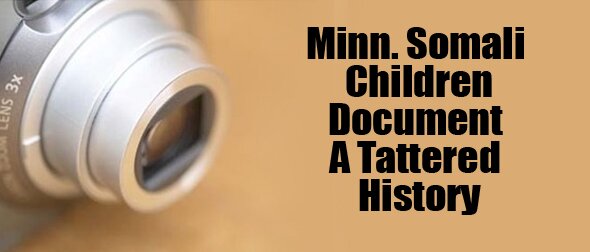![]()

At the Minnesota International Middle School, a charter school that enrolls mostly East African students, groups of elders from the local Somali community wander the halls between classes and convene in several “elders corners” throughout the day, always ready to dispense advice and wisdom and serve as good examples.
But the bearded old men and the women in hijabs serve another purpose. They’re a symbolic link for Somali youngsters whose African roots have been obscured by years of civil war that has destroyed many photos, birth and death documents, archives and writings.
Now, a school project is enlisting a group of students to rebuild a record of the Somali people. With digital cameras and notebooks, 40 eighth-graders are collecting the stories of their parents and grandparents, their schools and mosques, their customs and traditions.
“I interviewed my dad,” said Halima Jama, 13. “He told me about how he would feed and milk the camels. He graduated from high school, but then the civil war broke out between the tribes.”
Most of the students at the International Middle School were born in America or, like Halima, in refugee camps in Kenya. Their parents and grandparents are among the hundreds of thousands of Somalis who fled the country in the last two decades, settling in large numbers in places like Minnesota, where the local population is estimated to be at least 30,000.
Minnesota Somalis have faced challenges entering Midwestern life, but success, too, as they cultivate their own institutions like the International Middle School and its companion elementary and high schools. About 900 students attend the elementary and middle schools, which share a warehouse-like building in an industrial stretch just north of downtown Minneapolis.
About 90 percent of the students are of East African descent, primarily Somali. The coursework is geared for the college-bound, but with an emphasis on African culture and language and special help for students with weak English skills. The library is stocked with books about Africa but also popular English titles like the “Twilight” series and “The Princess Diaries.”
“Traditional schools were trying to meet the needs of these students, but they were overwhelmed,” said the middle school principal, Abdirashid Warsame. “Thirty-four hundred refugee students showed up in Minneapolis, and they didn’t know what to do with them.”
In 1996, Warsame helped establish an adult re-training program for Somali refugees that quickly morphed into the school, a natural step in a state with a strong charter-school movement. The school has a diffuse leadership structure that Warsame said is typical of the Somali people: “Teacher, parent, administrator, board member — it’s all sort of the same thing,” he said.
About five years ago, Warsame was watching a cable access program about local Somali issues that featured an appearance by a Columbus, Ohio-based photographer and Somali immigrant named Abdi Roble. Along with a freelance writer, Doug Rutledge, Roble was embarking on a project they dubbed the Somali Documentary Project. They were interviewing and photographing Somali immigrants, hoping to assemble an archive of Somali experience.
“The idea is to build a history for a people who lost it,” Rutledge said.
Warsame struck up a working relationship with the journalists that included a joint trip to a Kenyan refugee camp. Last year, the three started what Roble calls the “Kids with Cameras” class for a group of high schoolers, which Roble and Rutledge travel to Minnesota from Ohio once a week to teach.
This year, they decided to try it with middle schoolers. Every Monday and Tuesday, the two men convene the two classes of 20 students each, where they teach them about camera hardware and photography techniques, interviewing and narrative writing, and other storytelling skills. Each student’s goal for the semester is to assemble a portfolio of pictures and stories, some of which will end up in a traveling exhibit and someday, the journalists hope, a permanent museum of the Somali experience.
Many of the students, like Halima Jama, chose their parents as subjects. Megan Abdirahman, 13, learned about how hard her parents had to work when they first arrived in the United States to make enough money to help support family back in Somalia.
Others chose the middle school itself. Ruqiya Warsame, 13, took pictures of students and classes and sporting events, finding some students camera-shy and others ready for their spotlight.
“At first, I thought it was going to be easy — it’s just writing and pictures,” Ruqiya said. “But it turned out to be really challenging, because you want to find the right words to go with the right picture and if you don’t, it doesn’t make sense.”
For many of the students, the class has sparked a new interest in their home country — and along with it, a desire when they get older to return to Somalia someday, to help rebuild not just the country’s collective memory but its civic life, its infrastructure, its stability as a nation.
“I know a lot about it now, even though I wasn’t born there,” Ruqiya said. “I want our culture to live, because maybe if I have kids I’ll tell them about everything Somalia was, and what it is going to be.”
____
WCCO






